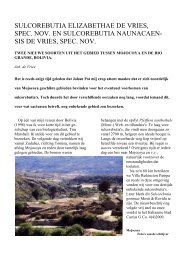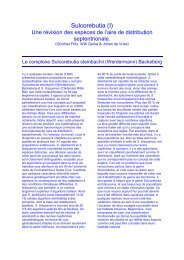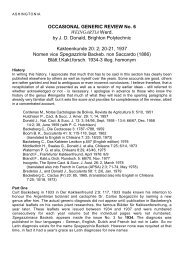South American Cactus Log (part XIX)
South American Cactus Log (part XIX)
South American Cactus Log (part XIX)
Create successful ePaper yourself
Turn your PDF publications into a flip-book with our unique Google optimized e-Paper software.
Orkho Abuelo, or Grandfather Mountain, came<br />
into view. I had been told that Walter Rausch had<br />
made a fascinating discovery there. So often in<br />
nature you have either beautiful spines and less<br />
attractive flowers or the other way around. The<br />
same is true with the leaves of bromeliads, with<br />
the exception of Guzmannia musaica where we<br />
find spectacular flowers and fascinating leaves.<br />
Sulcorebutia flavissima (Lau 338), as the name<br />
implies, has yellow spination and large darkpurple<br />
flowers, making this one of the most beautiful<br />
representatives of the genus. At the time of<br />
our visit there were thousands upon thousands of<br />
plants covering the mountain. It was not the flowering<br />
season, and I did not see the white variety<br />
which I have been told has been found.<br />
Aiquile greeted us with a myriad of Sulcorebutia<br />
mentosa (Lau 981). It is surprizing that<br />
this species, so common in its habitat, is found<br />
so rarely in collections. The large, very dark-red<br />
flowers make this plant outstanding in comparison<br />
to others. We rushed on to Totora from<br />
where there had been reported Sulcorebutia<br />
totorensis. There had been much discussion<br />
concerning this habitat and the validity of<br />
the name. Even I listed it in my collecting<br />
numbers, "totoralensis." On the road to Lagunillas<br />
near Totora I found a very beautiful magentaflowered<br />
sulcorebutia which I numbered Lau<br />
953 and later a form, Lau 954, which should<br />
correspond to the S. totorensis. I am including<br />
a colored photo in this article and I would be<br />
Fig. 145. Sulcorebutia krahnii. Photo Abbey Garden Press<br />
SOUTH AMERICAN CACTUS LOG<br />
PART <strong>XIX</strong><br />
ALFRED B. LAU<br />
A<strong>part</strong>ado 98, Cordoba, Veracruz, Mexico<br />
grateful for discussion on this controversial gem<br />
among sulcos. Totora reminds me of the hardest,<br />
toughest and almost tasteless cold meat that I<br />
ever ate in my life, served by a plump, squatty<br />
Quechua woman without any concern about her<br />
guests. I sometimes wonder why people do not<br />
boycott such places, but then there is no alternative,<br />
no competition to serve a decent<br />
"Churrasco", as the <strong>South</strong> <strong>American</strong> steak is called.<br />
Now we are nearing Comarapa and as<br />
such a center of cactus growing vegetation. Before<br />
reaching the area, to the north of the road,<br />
grows Parodia comarapana (Lau 951) in abundance,<br />
and with many deviations from the<br />
original description which gives "splitters"<br />
Fig. 146. Weingartia neocummingii from Comarapa.
much taxonomic activity. The species grows rather<br />
flat in the grassy soil and among rocks. The<br />
yellow flowers are not large but attractive. The<br />
whole area is strewn with large specimens of<br />
Gymnocalycium comarapense, which strongly<br />
resembles G. zegarrae, in fact I cannot accept the<br />
two as separate taxa and would rather call them<br />
forms. Gymnocalycium comarapense (Lau 950)<br />
at times has no lines dividing the areole sections<br />
which G. zegarrae (Lau 948), according to the<br />
description, always has. I have tried in habitat to<br />
seperate the two forms on that basis which was<br />
extremely difficult. Flowers are identical, only<br />
the spination in G. comarapense seems a little<br />
softer.<br />
Fig. 147. Sulcorebutia flavissima.<br />
Tambo is close to Comarapa and proved to me a<br />
great assistance and resting place. The New Tribes<br />
Mission, with headquarters in Cochabamba,<br />
runs a school for the missionary children there,<br />
and several teachers and missionaries have been<br />
friends of mine for many years. I could thus call<br />
Tambo home. In comparative luxury <strong>American</strong>style<br />
food was offered, and for a change I could<br />
sleep in a real bed. The parents of these children<br />
work far in the jungle, sometimes with tribes<br />
that number no more than 100 people. It takes a<br />
tremendous amount of spiritual and moral<br />
conviction to live with such isolated people, sometimes<br />
traveling for weeks from the nearest<br />
landing strip or river to get there, learning<br />
the language, difficult as it is, to reach just a<br />
handful of wild tribal individuals whose lives are<br />
so completely different from ours. I remember<br />
Fig. 148. Weingartia erinacea.<br />
the film that two missionaries took in an area<br />
which was invaded with sweat bees. The face of<br />
the photographed missionary was covered in seconds<br />
with these small prickling insects. Although<br />
they do not sting, their presence is most<br />
aggravating, and it is difficult to travel there without<br />
a head mask. Naturally, under the circumstances<br />
the parents cannot teach their children privately<br />
in their jungle surroundings. While I was<br />
there, political turmoil once again had the country<br />
in its grip. General Torres, who had earlier<br />
proclaimed himself President after a military<br />
coup, was leaning to the left, the right waiting for<br />
their chances.<br />
Fig. 149. Sulcorebutia cf. totorensis.
That the <strong>American</strong> missionaries were an easy target<br />
of abuse and adverse propaganda is always a<br />
risk which has to be taken into consideration. In<br />
the evenings there were always rumours of impending<br />
occupation of the school by leftists, and<br />
the school director during evening devotion had<br />
to quote Scripture verses of valor and bravery,<br />
preparing the children to withstand their fears<br />
with an unquenchable faith. For the Aguaruna<br />
Indian children, young in their Christian experience,<br />
coming from headshrinking practicies of<br />
the past, the example of the <strong>American</strong> missionary<br />
children was a convincing example.<br />
Comarapa is weingartia country, of the kind<br />
that can be cultivated with ease. I would separate<br />
weingartias into two categories: The easily grown<br />
neocummingii, erinacea with its variety catarirensis,<br />
longigibba, lanata, sucrensis, pilcomayensis,<br />
torotorensis, pulquinensis with the variety<br />
corroana and purpurea, and the difficult and<br />
hardbodied neumanniana, fidaiana, lecoriensis<br />
and cintiensis. Indeed, it might be wise to create a<br />
subgenus for the latter ones which all grow in a<br />
region remote from the former. Having done so<br />
with matucanas vs. submatucanas, for the sake of<br />
taxonomical order such a subgenus would not be<br />
out of place.<br />
Weingartia pulquinensis var. corroana (Lau<br />
341) is the most common, the village of Pulquina<br />
being situated a little south of Comarapa. The<br />
sturdy spines and bright yellow flowers govern<br />
the whole landscape, interspersed with Parodia<br />
columnaris (Lau 952) and Echinopsis pojoensis<br />
(Lau 339). (The latter identity I cannot confirm,<br />
but I do not see a marked difference between the<br />
species that grows at Puete Pojo and at Comarapa)<br />
E. comarapana (Lau 355) also grows here.<br />
Most of these plants grow in dense brush which<br />
gives way to clearings. Lobivia obrepanda (Lau<br />
959), which is found in many forms and situations,<br />
rounds off the caleidoscope of globular<br />
cacti. In addition to this come many cereoid cacti<br />
like armatocactus, cleistocactus and trichocereus<br />
which I am not at this moment considering in detail.<br />
A side-trip to Tukiphalla was a must. The dirt<br />
road (in an unbelievable condition) led us to a<br />
sandy mountain. In the yellow sand we saw<br />
yellow-spined plants with yellow flowers, very<br />
closely related to weingartia and almost camouflaged.<br />
This was Krahn's spectacular find, different<br />
from all others, Sulcorebutia (Rebutia)<br />
krahnii (Lau 340). As we launched further into<br />
the mountain wilderness, we at last found<br />
what we had been looking for, Weingaratia<br />
erinacea (Lau 342). The compactness of the<br />
almost round plants and the shortness of the spines<br />
reminds one of a small hedgehog in defensive<br />
position. The flowers of all of the first mentioned<br />
category, with exception of torotorensis<br />
and purpurea, are very sirnilar. Leaving Tambo,<br />
and the fellowship we enjoyed, we found near<br />
Mairana Weingartia neocummingii with its bristly<br />
spines, the softest to the touch of all weingartias.<br />
(Lau 958). Mairana also is home of Parodia<br />
mairanana var. atra (Lau 947). This is,in my experience,<br />
the easiest of all parodias in cultivation.<br />
The showy red flowers are frequent; the plant<br />
makes many offsets; but throughout the years it<br />
has come so close in appearance in cultivation to<br />
Parodia tuberculata that I see no difference at<br />
all. However, the two habitats are quite far a<strong>part</strong>.<br />
Another habitat that I did not want to miss<br />
was that of Ritter's great discovery, named for<br />
his sister Hilde Winter, Winterocereus aurei-<br />
Fig. 150. Winterocereus aureispinus in flower in habitat.<br />
spinus (Lau 957). Following the road towards<br />
Santa Cruz, we could see the snake-like yellow<br />
tails hanging over the cliffs, mostly beyond reach<br />
of the collector. Their orange-red flowers opened<br />
here and there, never in great quantities but in all<br />
<strong>part</strong>s of the stems, old and new.<br />
As in all articles, I will now try to describe a<br />
climatic adventure to which I had looked forward<br />
for some time and which, is a classic example of<br />
combining excitement and cactus research. There<br />
are people in the field who are fanatics, who see<br />
nothing but the <strong>part</strong>icular genus which is their<br />
specialty. No alternative subject for conversation<br />
is in their minds. Their whole way of thinking<br />
revolves around lobivias, matucanas, mammillarias<br />
or echinocereus. One acquaintance of mine<br />
did rather forego an invitation to a remote Indian<br />
village with strange rituals to witness which he<br />
could have never seen without my company, as I<br />
had boys from that region in my home and was<br />
accepted. He rather examined a mountain range<br />
that I had previously told him I had never climbed.<br />
Two days later I found him exhausted an a cot
in the village where he had left me. He had<br />
found nothing of value and spared me the physical<br />
exercise of examining the flora myself.<br />
Any serious cactophile would like to see<br />
Vatricania guentheri (Lau 899) in habitat.<br />
There is no sight quite like it. But to reach the<br />
area takes courage, perseverance and patience.<br />
Looking at the map, I realized that the trail<br />
would take me through La Higuera, the village<br />
where Ernesto "Che" Guevara, the onetime<br />
Fig. 152. Pedro Pujupat and Jorge Galindo (left)<br />
cleaning a stem of Winterocereus aureispinus.<br />
Fig. 151. Padre Schaller.<br />
confidant of Fidel Castro was killed while leading<br />
the guerrilla band with which he wanted to topple<br />
the Bolivian regime. I had been told stories in Lagunillas,<br />
to which he had send men to buy supplies,<br />
which indicated their hardships in barren and roadless<br />
territory, often without water or food, beset by<br />
many ailments and diseases and having little or no<br />
co-operation by the local extremely poor farmers.<br />
Many of them fled to safer areas anyhow. Yet La<br />
Higuera had to be traversed in order to get to my<br />
destination. Around the middle of the day we arrived<br />
in Pucara, coming from Vallegrande, across a<br />
very rocky dirt road. We had been told that this was<br />
the end of any transitable line.<br />
From here on it would be on foot. Sitting on the<br />
bench in the dusty, primitive park I spotted a redhaired<br />
bearded man with a European flair. I approached<br />
him and asked: "Are you the local priest?" Eagerly<br />
he answered affirmatively and invited me for<br />
lunch in the "parroquia". We were four: Pedro Pujupat<br />
and Wilfredo Cunachi, the two Aguarunas, and<br />
Jorge Galindo. The priest, Roger Schaller, was from<br />
the French-speaking <strong>part</strong> of Switzerland. He lived<br />
all by himself, had no nun to do his cooking, washing<br />
and ironing which I had observed in other parroquias.<br />
He looked a little unkept, moving among<br />
rough people of Quechua origin, eating their kind of<br />
food, trying to live their kind of life. He had a brilliant<br />
mind. Hardly ever a person like myself gave<br />
him the pleasure of conversing intelligently, covering<br />
many aspects of life and interests. He had erased<br />
any memory of a convenient existence, having<br />
killed his past and living for these people of Pucara.<br />
The diminutive man grew in stature as I came to<br />
know him. He had learned humility, the most difficult<br />
lesson in life that very few among us ever<br />
achieve.<br />
(to be continued)
Originally published in C.& S.J.(US) 1982:54 (p. 123-126)<br />
Reproduced with the permission of the author and the publisher.







